

The Anatomy of Food
Text and Photography
by
Füsun Atalay © 2004
As long as food has been a fascination with mankind, so has been the search for creative, humorous and often unusual nomenclature for concoctions to please or tease their palate.
Anyone who has read Macbeth will remember, with a good measure of trepidation, the scene of the three wicked witches circling the cauldron chanting spells and adding bizarre ingredients to their stew—
"eye of newt and toe of frog,
Wool of bat and tongue of dog."
Fortunately, we don't consume such unappetizing items; however, even among the delightful menus of the world, there are a good number of food names which may cause a few seconds of apprehension and curiosity before trying them.
Names of foods we take for granted as part of food culture travel long and far, bearing names of people, places, and even parts of the anatomy- be it man or beast. Many of us can easily come up with elbow macaroni, angel hair pasta, buffalo wings or damper dogs as a case in point. Yet there are other gastronomical entities out there which may be less well known by name, appearance or taste.
Let’s start with four evangelists: onions, celery, carrots, and parsley. They are the very foundation for cooking food with the best flavour, and as this foursome cook together in a finely diced assembly, they lose their individuality to take on a single flavour essence. When that is achieved, the dish is said to be in harmony.
Similarly spiritual harmony of being at one with the universe and the creator of such a universe was the inspiration for what, ironically in modern times, has become associated with beer and partying rather than praying. Pretzels were first made by monks in Southern Europe as a reward for students who learned their prayers. The crossed ends of the pretzel represent praying hands crossed over the chest.
People throughout history have also expressed their spiritual devotion, religious beliefs and appreciation of good food by celebrations and feasts. How many of us, for example, are familiar with red-eye gravy, fish eye pudding, nuns’ tummies, ladies’ thighs or Santa Lucia’s eyes ?
Saint Lucia was an Italian Christian who lived in Sicily in the 4th century. She was a very kind person. There was a man who loved her very much but she didn't like him. What this man loved most about Saint Lucia were her eyes; so she gave him her eyes. Then a miracle happened and she grew back her eyes which were even more beautiful then ever. The man asked for those eyes too, but she refused to give them so he killed her with a knife into her heart.
Thus the name Occhi di Santa Lucia (Eyes of St. Lucy) was given to fried cookies made on December 13 every year to celebrate her life and kindness.
According to legend and not necessarily facts, the 7th President of the United States, Andrew Jackson (1767-1845), who was an American General at the time, called his cook over to tell him what to prepare for that evening’s meal.
The cook had been drinking moonshine whiskey the previous night, so his eyes were blood-shot red. General Jackson told the cook to bring him some country ham with gravy as red as his eyes. Nearby, some men heard the general and from then on, ham gravy became red eye gravy.
Hushpuppies, also know as corn dodgers, are very popular throughout the Southern United States. These finger-shaped dumplings of cornmeal are deep-fried and served with fried catfish.
Among the many interesting stories, the oldest one attributes its origin to a group of Ursuline nuns from France who had settled in what was called New Orleans shortly after 1727. The nuns called their concoction croquettes de maize.
One of the stories for naming these corn fingers, hush puppies goes to the confederate soldiers. While they were preparing their meals beside a campfire, if they detected Yankee soldiers approaching, they would toss their yapping dogs some of the fried cornmeal cakes with the command "Hush, puppies!"
Another culinary delight, ladyfingers, seem to have earned their name by their shape and delicacy reminiscent of a gentlewoman's fingers - These oval-shaped cookies or cakes are also known around the world as Boudoir biscuits, sponge biscuits, sponge fingers, Naples biscuits, Savoy biscuits and interestingly langue de chat (cat’s tongue).
The cuisines of the world seem to have taken a particular interest in naming certain delicacies after female the anatomy. Another example of this practice shows itself in a naughty name given to a pastry in Southern Italy. Zinne de monaco (nun’s thighs) are round cakes topped with a white icing and a cherry in the middle.
Another sweet named after nuns, nuns’ tummies, originates in Portugal. However, these sweet egg puddings may be named not so much because of their appearance but rather because of the appearance of the person who may end up like a fat nun after eating too many of these tasty treats.
Kadin budu köftesi which translates as ladies' thighs meatballs, hails from Turkey. In this case, the dish is named so because of its delicate texture and delectable taste which result from the right combination of herbs and seasonings. Perhaps the smooth, oval shapes of the meatballs also contribute in conjuring up the image suggested by the name.
Bear paw bread is an impressive looking Pueblan bread. Crusty, delicious and easy to make it is named after what it looks like: the paw of a bear. Its origins is known to be in the Rio Grande area of New Mexico.
Last but not least are the unusual to look at but delicious to eat ossi dei morti (bones of the dead), so named because they are dry and brittle like old bones. Italians bake these unusual sweets every year on All Souls' Day in November in remembrance of their dead relatives .
So, whether it is ladies' fingers, nuns' tummies, St. Lucy's eyes, Pope's nose or bones of the dead you're eating, if you stop for a second and think of its origins, you may smile with delight and nostalgia, or chuckle with the humour and appreciation that go into the name.
---------
Occhi di Santa Lucia (St. Lucy's Eyes) ~ Makes approximately 60
~ Source: Mary Ann Esposito, PBS Ciao Italia
4 2/3 to 5 cups all-purpose lour
1 cup sugar
1/2 teaspoon salt
2 large eggs, at room temperature
1 cup milk
Vegetable oil for deep-frying
Confectioners' sugar for sprinkling
4 2/3 to 5 cups all-purpose lour
1 cup sugar
1/2 teaspoon salt
2 large eggs, at room temperature
1 cup milk
Vegetable oil for deep-frying
Confectioners' sugar for sprinkling
In a bowl, mix together 4 cups of the flour, 2 tablespoons of the sugar, and the salt.
In a medium bowl, whisk the eggs and milk together. Stir the mixture into the flour mixture, adding enough additional flour to make a soft ball of dough.
On a floured surface, knead the dough until smooth and no longer sticky. Divide the dough in half. Roll out each piece into a rectangle about 15 by 12 inches. Sprinkle each rectangle evenly with half of the remaining sugar and roll up tightly like a jelly roll. Cut the rolls into ½-inch-thick slices.
In a deep-fryer or deep heavy pot, heat the vegetable oil to 375ºF. Fry the cookies, a few at a time, until golden brown. Remove with a slotted spoon to brown paper to drain. Sprinkle the cookies with confectioners' sugar and serve.
Fish Eye Pudding
Source: Marcia Adams
1 cup large pearl tapioca (not instant)
4 cups of water
3 cups brown sugar
pinch salt
1 cup large pearl tapioca (not instant)
4 cups of water
3 cups brown sugar
pinch salt
Soak tapioca in water overnight in a large crock pot container. Next morning, add brown sugar and pinch of salt. Cover and cook on low setting for 12 hours.
Before serving, add:
1.5 tsp vanilla
1 cup walnuts
Stir, turn into bowl, and cover top with whipped cream. The large pearls of tapioca are the "fish eyes".
Bear Paw Bread
This recipe can be frozen, well wrapped, for up to three months.
1 cup hot water
1 teaspoon solid vegetable shortening, butter, or margarine
1 teaspoon honey
pinch of salt
1 package active dry yeast
1/4 cup warm water (110 degrees F)
5 cups all purpose flour
Place the hot water, shortening, honey, and salt in a large bowl; stir to melt shortening.
Dissolve yeast in the warm water in a small bowl. When liquid in the large bowl has cooled to room temperature, stir in the yeast mixture. Add flour 1 cup at a time, beating well after each addition. After 4 cups have been added to the dough, place the remaining 1 cup on a board and turn out dough over flour. Knead dough until smooth and elastic, 10 to 15 minutes.
Place dough in a lightly greased very large bowl, turning to grease top of dough. Cover with a kitchen towel and let rise about 1 1/2 hours, or until doubled in bulk. Turn out on a floured board and knead again for about 3 minutes.
Grease 2 (9-inch) pie pans or 2 baking sheets. Divide dough in half and form each piece into a flat circle about 8 inches in diameter. Fold each circle almost in half, allowing the bottom to extend about an inch beyond the top. With a sharp knife, slash the dough twice, cutting through both layers of dough, about halfway back to the fold. This will form three separated sections - the bear's paw. Place each loaf in a greased pie plate, or on a baking sheet, curving the folded side in a crescent shape. Separate the slashes. cover loosely with a towel and let rise until doubled in bulk.
Preheat oven to 350 degrees F and place a shallow pan of hot water in the center of bottom rack of the oven. Place loaves on the top rack. Bake about 1 hour, or until lightly browned and bread sounds hollow when tapped. ~ Makes 2 loaves.
Copyrighted Material ~ Copyright © 2004 All Rights belong to Füsun Atalay





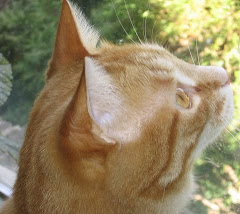








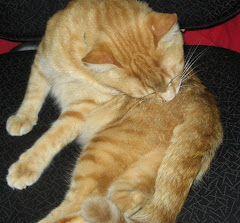



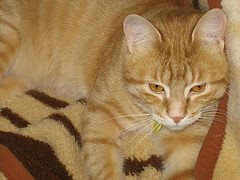














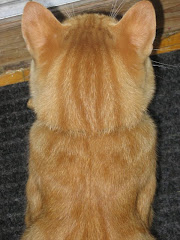
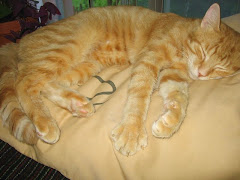
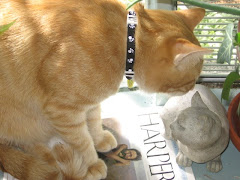

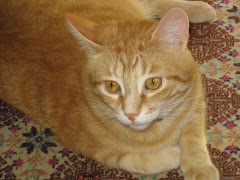


No comments:
Post a Comment